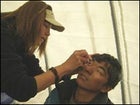As the medical director of both Yellowstone National Park and the highest clinic in the world”“Dr. Luanne Freer has learned to handle extremes. She’s treated the victims of avalanches, animal attacks, and HAPE (pulmonary edema) in wilderness conditions with only the barest of medical supplies. �����ԹϺ���‘s MELANIE LIDMAN caught up with her to find out how she handles emergencies at 17,600 feet.
Dr. Freer, Everest ER
 Everest ER
Everest ERDr. Freer, Everest ER
 Dr. Freer treating snow blindness
Dr. Freer treating snow blindness
Which came first, your love of travel or your interest in medicine?
I knew I wanted to be a doctor when I was seven years old. I seemed to be drawn to helping people in pain and not repulsed by blood like so many of my buddies. The travel bug hit me after medical school, when I finally had a little free time to get out and explore the world.
Is it ever frustrating to be so close to Everest and not climb it?
I have no desire to summit the mountain, but I am definitely drawn to climb. I make sure to get my crampons out on the ice at least a few times a week up here to stay in shape. I’ve been to Camp 1 and hope some day to climb a little higher. I have a goal of climbing as high as my body feels comfortable, but will not use supplemental oxygen – a personal decision.
What’s the most rewarding part of running the Everest ER?
It’s all about the Sherpa people. My ten years of experience in Nepal have connected me with the most inspiring people I’ve ever met. Several families include me as one of their own. I have children I’m sponsoring in school. I feel like part of this wonderful community. Of course, saving a life is an amazing reward, but it’s the ongoing relationships that seem to be the biggest draw for me.
Can you tell me a little bit about sherpa involvement at the Khumbu Climbing School and Everest ER?
This was the first year that a sherpa, Serki Sherpa, took over the first aid class at the climbing school. What a great thing to watch: for a project to become self sustaining so quickly. Serki has helped us teach over the years, at first just translating the medical words, then giving the lectures, then actually changing the curriculum to better fit the needs of the students. It’s a wonderful feeling to hand it over, and a great sign to the Sherpa people that their own people have the expertise to teach.
What are the medical challenges working in such an extreme location?
Quite simply, lack of your usual setting, backup, and equipment. We don’t have x-ray machines, blood tests, CAT scans. We need to rely on our educational preparation and basic skills of evaluation.
What’s a typical day at Base Camp?
We wait for the sun to hit the tent. The sun warms EBC very quickly. We enjoy breakfast “on the beach” in the sun, watching the camp wake up. The clinic is open from 9am – 5 pm, and our first patients usually arrive right on time. We are available for after hours emergencies, but establishing clinic hours helps our staff stay rested and fed…no one wants to talk about diarrhea while in the middle of dinner!
Have there been any moments when you’ve doubted that the Everest ER mission will succeed?
Definitely yes. The first season was full of disappointments, equipment failures, naysayers … I cried a lot and wondered why I was arrogant enough to believe I could actually do this. But then we saved a porter who was moments from death from high altitude cerebral edema. We sent him home to his wife and children. Suddenly, all the discomfort and hassle was erased, and I knew we had to soldier on.
What is your most memorable rescue (on or off the mountain)?
There are several. Watch the 10-minute video clip on YouTube (below) and you can see the Korean climber with frostbite, the Italian with a broken neck and brain bruise. These were particularly memorable. Joe Hughes, whose family I have an enduring relationship with, was saved from high altitude pulmonary edema in 2004, and continues to support our clinic.
What does it take to be a medical professional in such a remote location?
It takes lots of self-education in wilderness and mountain medicine that is not part of most medical school curricula. Obtaining a fellowship credential in wilderness medicine is a good start. (Check out for more information.)
Is this what you envisioned yourself doing as a career?
I didn’t have a clue when I was younger, having been groomed for a career in academic inner city emergency medicine. The way I ended up here was simply a product of following my passion for the mountains and luckily being open minded enough to follow them. I suppose I can thank my intuition for just knowing it was the right thing to do. I feel really lucky to have been in the right place at the right time and to have the support of my work colleagues to let me leave to develop this clinic.
What’s the first thing you do when you get down from Base Camp?
Take a long hot shower!
to make a donation to Everest ER.

